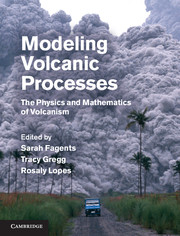Book contents
- Frontmatter
- Contents
- Contributors
- Chapter 1 Introduction
- Chapter 2 Magma chamber dynamics and thermodynamics
- Chapter 3 The dynamics of dike propagation
- Chapter 4 Dynamics of magma ascent in the volcanic conduit
- Chapter 5 Lava flows
- Chapter 6 Unsteady explosive activity
- Chapter 7 Unsteady explosive activity
- Chapter 8 Sustained explosive activity
- Chapter 9 Modeling tephra sedimentation from volcanic plumes
- Chapter 10 Pyroclastic density currents
- Chapter 11 Magma–water interactions
- Chapter 12 Deep-sea eruptions
- Chapter 13 Volcano–ice interactions
- Chapter 14 Modeling lahar behavior and hazards
- Chapter 15 Introduction to quantitative volcano seismology
- Chapter 16 Volcano acoustics
- Chapter 17 Planetary volcanism
- Index
- Plate section
- References
Chapter 11 - Magma–water interactions
Published online by Cambridge University Press: 05 March 2013
- Frontmatter
- Contents
- Contributors
- Chapter 1 Introduction
- Chapter 2 Magma chamber dynamics and thermodynamics
- Chapter 3 The dynamics of dike propagation
- Chapter 4 Dynamics of magma ascent in the volcanic conduit
- Chapter 5 Lava flows
- Chapter 6 Unsteady explosive activity
- Chapter 7 Unsteady explosive activity
- Chapter 8 Sustained explosive activity
- Chapter 9 Modeling tephra sedimentation from volcanic plumes
- Chapter 10 Pyroclastic density currents
- Chapter 11 Magma–water interactions
- Chapter 12 Deep-sea eruptions
- Chapter 13 Volcano–ice interactions
- Chapter 14 Modeling lahar behavior and hazards
- Chapter 15 Introduction to quantitative volcano seismology
- Chapter 16 Volcano acoustics
- Chapter 17 Planetary volcanism
- Index
- Plate section
- References
Summary
Overview
Magma–water interaction is an unavoidable consequence of the hydrous nature of the Earth’s crust, and may take place in environments ranging from submarine to desert regions, producing volcanic features ranging from passively effused lava to highly explosive events. Hydrovolcanism is the term that describes this interaction at or near the Earth’s surface, and it encompasses the physical and chemical dynamics that determine the resulting intrusive or extrusive behavior, and the character of eruptive products and deposits. The development of physical theory describing the energetics and the hydrodynamics (dynamics of fluids and solids at high strain rates) of magma–water interaction relies on an understanding of the physics of water behavior in conditions of rapid heating, the physics of magma as a material of complex rheology, and the physics of the interaction between the two, as well as detailed field observations and interpretation of laboratory experiments. Of primary importance to address are the nature of heat exchange between the magma and water during interaction, the resulting fragmentation of the magma, and the constraints on system energetics predicted by equilibrium and non-equilibrium thermodynamics. Taken together, these approaches elucidate the relationships among aqueous environment, interaction physics, and eruptive phenomena and landforms.
Introduction: magma and the hydrosphere
The vast majority of volcanic eruptions take place under water because most volcanism concentrates at mid-oceanic ridges where new oceanic crust is produced. By definition, every kind of extrusive subaqueous volcanism on Earth is hydrovolcanic since some degree of water interaction must take place. The hydrosphere also exists in continental areas, as the consequence not only of lakes and rivers, but also of groundwater and hydrous fluids that circulate in joints and faults in the upper crust and fill pore space in sedimentary rocks. Such locations are typically referred to as geohydrological environments. As a consequence, subaerial volcanism is commonly influenced by magma–water interaction. Chapter 12 describes deep-sea eruptions in greater detail, whereas this chapter focuses on magma–water interaction in surface and near-surface environments.
- Type
- Chapter
- Information
- Modeling Volcanic ProcessesThe Physics and Mathematics of Volcanism, pp. 230 - 257Publisher: Cambridge University PressPrint publication year: 2013
References
- 34
- Cited by



